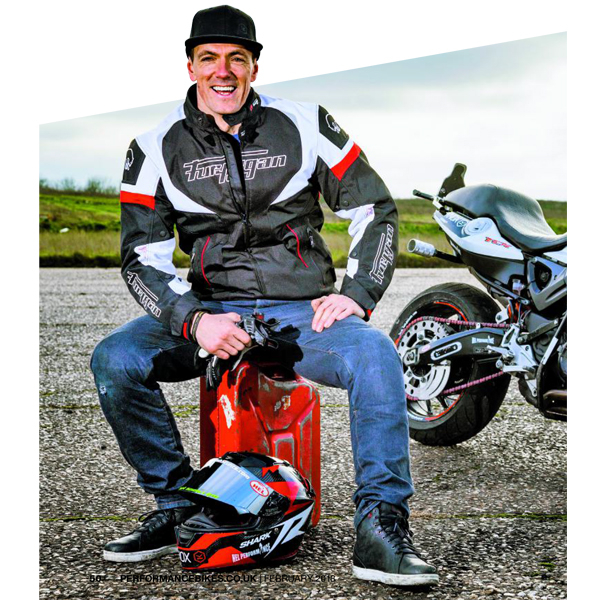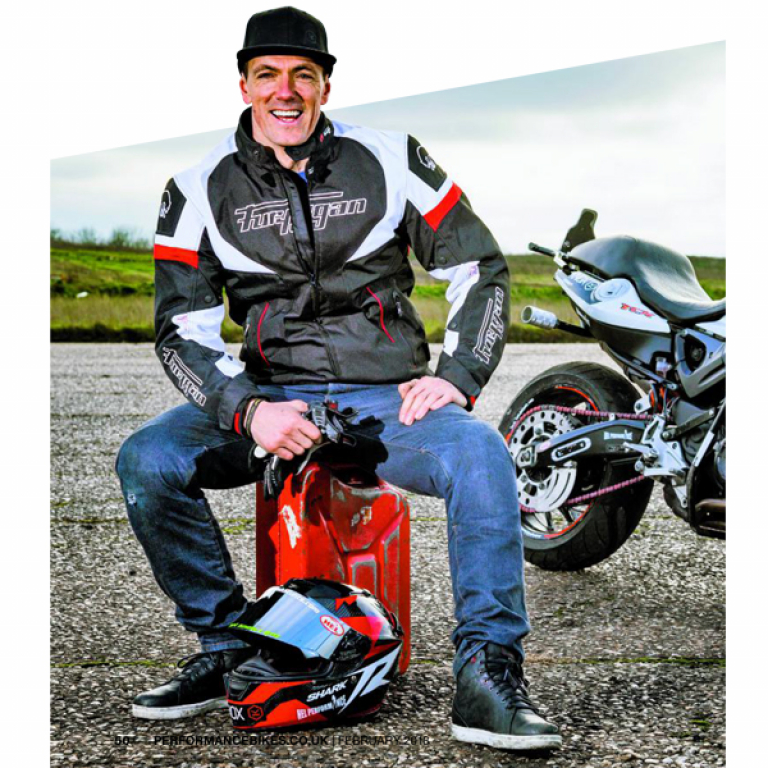Stuntman To The Stars ! Meet Rick English
CONSIDER yourself a bit of a film buff? Reckon you can see through CGI and special effect action scenes in movies? Well, defeating such cynicism and providing ever more spectacular footage is what keeps Rick English in work as a bike-riding stunt man, listed on the British Stunt Register for
directors and film crews worldwide to hand-pick if he suits the flick they’re producing.
And he often does: his CV includes Bond films, Mission: Impossible, Kingsman, Ghost Rider and more... he’s also appeared on TV, and in commercials, too – when PB caught up with him on a practice day, he’d just picked up a battered scooter in preparation for playing a London scooter scally for a major high street brand. If you need a wheelie, powerslide or a VMAX ridden through the desert, he’s your man. So how the hell does an ordinary bloke from the south east wind up working with Hollywood bigwigs?
“When I was about seven, I watched TV stunt man series ‘The Fall Guy’ and the Burt Reynolds film ‘Hooper.’ Reynolds in particular was a bit of a hero of mine. In the opening scene of that film, you see him pulling on his armour, his leathers, taking a swig of whiskey and then getting on his bike to shoot a crash scene. I thought that was the coolest thing, and I knew right then that’s what I wanted to do.
“I did fall into real life for a short time, and initially
I had a job as a personal trainer. But all the time I was riding bikes, doing a bit of club racing, and still thinking about getting into films, but initially through my interest in martial arts.
“I started to work in a gym in London’s west end and you’d get a lot of actors and directors coming in – I got my first foot in the door that way.”
For anyone wanting to make a living as a stunt double, you need to be part of a recognised body – in the UK, that’s the British Stunt Register, run by an actors’ union. You need to train across six different disciplines of stunt performance, and reach a certain standard in all. Accredited members are then added to a directory for directors and stunt team co-ordinators, which lists height and physical attributes as well as areas of expertise, to help find close matches where body doubles are required.
Getting a break
After some early work on the martial arts side, he got his biking break in 2000. “It was just riding through traffic in ‘Three Blind Mice’, but it was my first paid role involving bikes.”
From there, Rick’s stunt roles quickly went up a notch to some big flicks – over the years, he’s played a part in Batman movies, Bond films, and one-offs like ‘The Boat That Rocked’. But when it comes to bike stunts, two franchises stand out for Rick – one for obvious reasons, the other more personal...
“My favourite bike scenes were in ‘Ghost Rider II’, not because it’s the best or most popular film I’ve worked on, but because there was lots to do – I like to be busy, and there was a lot of riding in that film. It’s not about the money for me; I just love doing cool stuff and going to cool places, and in that respect it was the best job I’ve had lots of riding, and also some ‘wire work’, which is basically any kind of stunt that
requires you to fly through the air, so you’re
on a thin wire and yanked away!
“Because it was an over-the-top sort of film, rather than something that had to be realistic, you can do stuff that’s more fun and get away with it. The supernatural sort of scene is great to do there was lots of fighting and riding to do, and it was shot in Transylvania and Turkey, which were amazing places to see.
“Though when they first called, they mentioned wheelies would be required, and it turned out I’d be riding a Yamaha VMAX. They’re not very easy to get up, they just wheelspin!”
If you’re a cinema regular, Rick’s work on ‘Mission Impossible: Rogue Nation’ is probably the best of his handiwork, performing in the chase scene involving S1000RRs – and being the man responsible for the big highside just behind Tom Cruise that would eventually go on to be the lead image and scene for the trailers and promotional material. It’s not fake, either – he really did flick himself of one of the 20 or so S1000RRs reduced to scrap in the making of the film...
“I remember when we first arrived, and they’d got all these RRs – ex-press and demo bikes I think – and I thought, ‘Great, there’ll be some spares leftover for my track bike!’ But at the end there was barely enough left to build a rideable bike – they were crashed, ridden down steps and all sorts, just about everything got damaged eventually.”
Crashing on purpose
Humans are born with two natural fears: loud noises, and falling. So flicking yourself off a perfectly good motorcycle goes against everything we’re hard wired to do, before we develop further self-preservation instincts... How the hell do you prepare to have such an ugly crash on purpose?
“I tend not to think about it as a crash, I work on the mechanics and physics of what I have to do, and then deal with the aftermath as best I can, though it’s different every time. It’s all in the preparation – you and the team work on making sure there’s nothing to hit and nobody is going to run you over. You do everything to avoid injury, because that holds the job up and prevents you from working.
“I highsided in MI:5 by jumping on the rear brake at 50mph then releasing it – it’s pretty inevitable when you lock the rear and it steps out, then you release, that it’s going to flick you up – trying to do it on the throttle is harder, it might grip and drive, or something else you don’t expect, and potentially run into someone like Tom Cruise... And you try to do these stunts in one take, though sometimes they need it from different angles, so you do have to repeat it.
“I almost got away with it, but I managed to stretch a ligament in my knee as I tumbled. Fortunately it was fairly minor – I strapped it up for another 10 days of shooting so I could get the job done.
“The lay-down I did for Ghost Rider was actually relatively straightforward – ride at 60-70mph, lock the back up, turn the bars and just wait to go down, making sure you don’t get underneath the bike and trying not to get hurt, obviously!”
“Tom Cruise is so focused... and fast”
Working on Mission: Impossible meant working closely with A-lister Tom Cruise. We’ve all heard the gossip and rumours. So go on... what’s he like?
“He loves to do a lot of action in his films – he’s into bikes and cars, so he pushes to get them involved.
I remember coaching him at Rockingham one day.
I was riding round, out on to the straight doing over 130mph and thinking, ‘This guy’s an actor!’
“He has to be reined in on set, because he wants to do everything himself, and push it – he hates having to use rigs or anything false. He wanted to do a chase scene in shorts and flip-flops, and he insisted on doing it without a helmet so you could see it really was him, to make it worth him doing the riding rather than a stunt double. He had to do the scene where I highsided with his bike on a rig from the camera car, as that was the only way to get everything consistent and correct for one take, but he was against it. That’s the appeal of the films, people want to see him doing those things.
“He’s very focused and intense, but cool to work with, and likes hanging out with the stunt team, because he enjoys doing it, and generally brings a good energy to the job. He’s been out to lunch with us when we’re out practicing somewhere – we’ll be in the pub and he’ll just be talking bikes like everybody else.
“He’s good to the fans, too – after one scene in a BMW M3, he drove over to a fence closing the set where some public had gathered. He signed a load of autographs, and then did some donuts for them!”
How to be movie-ready
Obviously, you can’t just knock on the door of a production company, wave a provisional licence and get handed a S1000RR to throw at the scenery. As Rick does with martial arts, or fencing, or driving (skills he also offers), he spends a lot of time on two wheels honing his reflexes and understanding of bike control.
We went to see him on one of his regular practice days, where he spends time on an airstrip on a stunt show-spec F800R. Here, he can develop control for wheelies, skids, stoppies and general on-the-edgeness that translates to the skills often required. But the variety of his film work means he has to ride most things to ensure he stays sharp and can turn his
hand to most things.
“I have a lot of bikes. As well as this BMW, I have an
S1000RR for trackdays, and I used to race 600s at club level. I also have motocross bikes, trials bikes and recently got into flat-track, too. Understanding different bikes and surfaces makes me better at my job, but I also do it because I enjoy it. You wouldn’t think club racing would be useful for a film, but MI:5 was knee-down, elbow-to-elbow on Moroccan twisties: basically racing!
“I train with show stunt riders, but I don’t ever do shows, and I don’t train quite the same way. I don’t need to push it to the same extreme – it’s about throttle and brake control for me, and the balance. They’ll crash 20 times a session trying something new, but if I hurt myself going too far, I’ll be out of work for a while.
So you need to do these things, and be able to adapt, too. I don’t do enduro, though – any sport where your bike needs handles to pull it out of a bog isn’t for me!
“When I chose my six stunt disciplines, I chose things I was interested in anyway, even if that’s not necessarily where I want to work – if you’re not into it, you won’t get to the required standard and maintain it for when you might need it.”
With the fast-idle and braking mods to his F800, Rick can hold this up all day
Interview courtesy of Performance Bikes Magazine


CONSIDER yourself a bit of a film buff? Reckon you can see through CGI and special effect action scenes in movies? Well, defeating such cynicism and providing ever more spectacular footage is what keeps Rick English in work as a bike-riding stunt man, listed on the British Stunt Register for
directors and film crews worldwide to hand-pick if he suits the flick they’re producing.
And he often does: his CV includes Bond films, Mission: Impossible, Kingsman, Ghost Rider and more... he’s also appeared on TV, and in commercials, too – when PB caught up with him on a practice day, he’d just picked up a battered scooter in preparation for playing a London scooter scally for a major high street brand. If you need a wheelie, powerslide or a VMAX ridden through the desert, he’s your man. So how the hell does an ordinary bloke from the south east wind up working with Hollywood bigwigs?
“When I was about seven, I watched TV stunt man series ‘The Fall Guy’ and the Burt Reynolds film ‘Hooper.’ Reynolds in particular was a bit of a hero of mine. In the opening scene of that film, you see him pulling on his armour, his leathers, taking a swig of whiskey and then getting on his bike to shoot a crash scene. I thought that was the coolest thing, and I knew right then that’s what I wanted to do.
“I did fall into real life for a short time, and initially
I had a job as a personal trainer. But all the time I was riding bikes, doing a bit of club racing, and still thinking about getting into films, but initially through my interest in martial arts.
“I started to work in a gym in London’s west end and you’d get a lot of actors and directors coming in – I got my first foot in the door that way.”
For anyone wanting to make a living as a stunt double, you need to be part of a recognised body – in the UK, that’s the British Stunt Register, run by an actors’ union. You need to train across six different disciplines of stunt performance, and reach a certain standard in all. Accredited members are then added to a directory for directors and stunt team co-ordinators, which lists height and physical attributes as well as areas of expertise, to help find close matches where body doubles are required.
Getting a break
After some early work on the martial arts side, he got his biking break in 2000. “It was just riding through traffic in ‘Three Blind Mice’, but it was my first paid role involving bikes.”
From there, Rick’s stunt roles quickly went up a notch to some big flicks – over the years, he’s played a part in Batman movies, Bond films, and one-offs like ‘The Boat That Rocked’. But when it comes to bike stunts, two franchises stand out for Rick – one for obvious reasons, the other more personal...
“My favourite bike scenes were in ‘Ghost Rider II’, not because it’s the best or most popular film I’ve worked on, but because there was lots to do – I like to be busy, and there was a lot of riding in that film. It’s not about the money for me; I just love doing cool stuff and going to cool places, and in that respect it was the best job I’ve had lots of riding, and also some ‘wire work’, which is basically any kind of stunt that
requires you to fly through the air, so you’re
on a thin wire and yanked away!
“Because it was an over-the-top sort of film, rather than something that had to be realistic, you can do stuff that’s more fun and get away with it. The supernatural sort of scene is great to do there was lots of fighting and riding to do, and it was shot in Transylvania and Turkey, which were amazing places to see.
“Though when they first called, they mentioned wheelies would be required, and it turned out I’d be riding a Yamaha VMAX. They’re not very easy to get up, they just wheelspin!”
If you’re a cinema regular, Rick’s work on ‘Mission Impossible: Rogue Nation’ is probably the best of his handiwork, performing in the chase scene involving S1000RRs – and being the man responsible for the big highside just behind Tom Cruise that would eventually go on to be the lead image and scene for the trailers and promotional material. It’s not fake, either – he really did flick himself of one of the 20 or so S1000RRs reduced to scrap in the making of the film...
“I remember when we first arrived, and they’d got all these RRs – ex-press and demo bikes I think – and I thought, ‘Great, there’ll be some spares leftover for my track bike!’ But at the end there was barely enough left to build a rideable bike – they were crashed, ridden down steps and all sorts, just about everything got damaged eventually.”
Crashing on purpose
Humans are born with two natural fears: loud noises, and falling. So flicking yourself off a perfectly good motorcycle goes against everything we’re hard wired to do, before we develop further self-preservation instincts... How the hell do you prepare to have such an ugly crash on purpose?
“I tend not to think about it as a crash, I work on the mechanics and physics of what I have to do, and then deal with the aftermath as best I can, though it’s different every time. It’s all in the preparation – you and the team work on making sure there’s nothing to hit and nobody is going to run you over. You do everything to avoid injury, because that holds the job up and prevents you from working.
“I highsided in MI:5 by jumping on the rear brake at 50mph then releasing it – it’s pretty inevitable when you lock the rear and it steps out, then you release, that it’s going to flick you up – trying to do it on the throttle is harder, it might grip and drive, or something else you don’t expect, and potentially run into someone like Tom Cruise... And you try to do these stunts in one take, though sometimes they need it from different angles, so you do have to repeat it.
“I almost got away with it, but I managed to stretch a ligament in my knee as I tumbled. Fortunately it was fairly minor – I strapped it up for another 10 days of shooting so I could get the job done.
“The lay-down I did for Ghost Rider was actually relatively straightforward – ride at 60-70mph, lock the back up, turn the bars and just wait to go down, making sure you don’t get underneath the bike and trying not to get hurt, obviously!”
“Tom Cruise is so focused... and fast”
Working on Mission: Impossible meant working closely with A-lister Tom Cruise. We’ve all heard the gossip and rumours. So go on... what’s he like?
“He loves to do a lot of action in his films – he’s into bikes and cars, so he pushes to get them involved.
I remember coaching him at Rockingham one day.
I was riding round, out on to the straight doing over 130mph and thinking, ‘This guy’s an actor!’
“He has to be reined in on set, because he wants to do everything himself, and push it – he hates having to use rigs or anything false. He wanted to do a chase scene in shorts and flip-flops, and he insisted on doing it without a helmet so you could see it really was him, to make it worth him doing the riding rather than a stunt double. He had to do the scene where I highsided with his bike on a rig from the camera car, as that was the only way to get everything consistent and correct for one take, but he was against it. That’s the appeal of the films, people want to see him doing those things.
“He’s very focused and intense, but cool to work with, and likes hanging out with the stunt team, because he enjoys doing it, and generally brings a good energy to the job. He’s been out to lunch with us when we’re out practicing somewhere – we’ll be in the pub and he’ll just be talking bikes like everybody else.
“He’s good to the fans, too – after one scene in a BMW M3, he drove over to a fence closing the set where some public had gathered. He signed a load of autographs, and then did some donuts for them!”
How to be movie-ready
Obviously, you can’t just knock on the door of a production company, wave a provisional licence and get handed a S1000RR to throw at the scenery. As Rick does with martial arts, or fencing, or driving (skills he also offers), he spends a lot of time on two wheels honing his reflexes and understanding of bike control.
We went to see him on one of his regular practice days, where he spends time on an airstrip on a stunt show-spec F800R. Here, he can develop control for wheelies, skids, stoppies and general on-the-edgeness that translates to the skills often required. But the variety of his film work means he has to ride most things to ensure he stays sharp and can turn his
hand to most things.
“I have a lot of bikes. As well as this BMW, I have an
S1000RR for trackdays, and I used to race 600s at club level. I also have motocross bikes, trials bikes and recently got into flat-track, too. Understanding different bikes and surfaces makes me better at my job, but I also do it because I enjoy it. You wouldn’t think club racing would be useful for a film, but MI:5 was knee-down, elbow-to-elbow on Moroccan twisties: basically racing!
“I train with show stunt riders, but I don’t ever do shows, and I don’t train quite the same way. I don’t need to push it to the same extreme – it’s about throttle and brake control for me, and the balance. They’ll crash 20 times a session trying something new, but if I hurt myself going too far, I’ll be out of work for a while.
So you need to do these things, and be able to adapt, too. I don’t do enduro, though – any sport where your bike needs handles to pull it out of a bog isn’t for me!
“When I chose my six stunt disciplines, I chose things I was interested in anyway, even if that’s not necessarily where I want to work – if you’re not into it, you won’t get to the required standard and maintain it for when you might need it.”
With the fast-idle and braking mods to his F800, Rick can hold this up all day
Interview courtesy of Performance Bikes Magazine



















